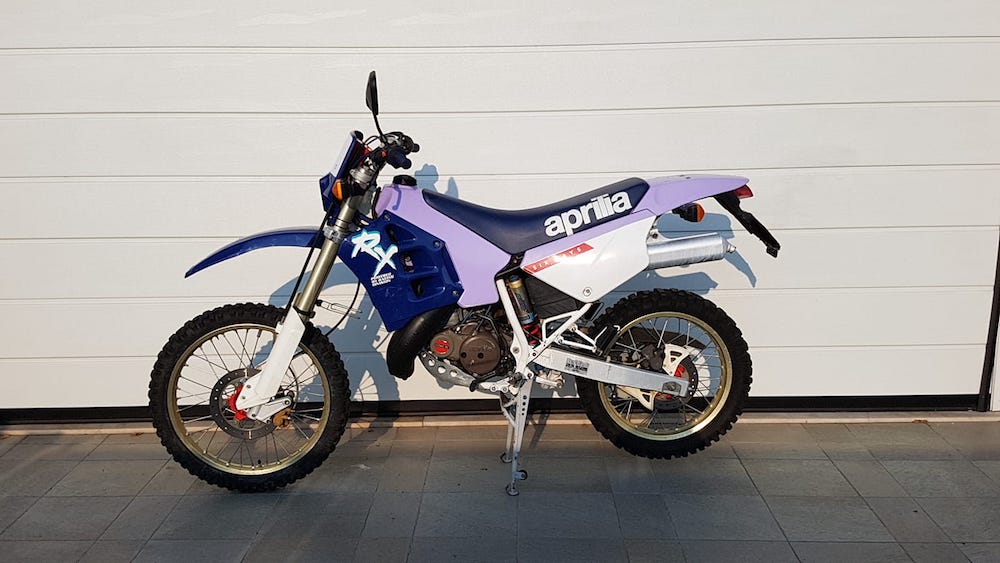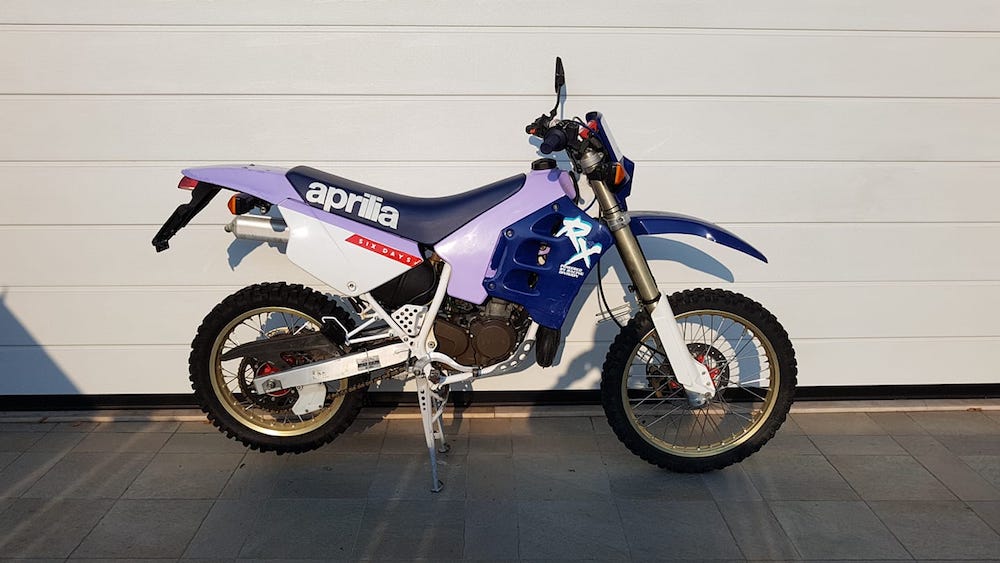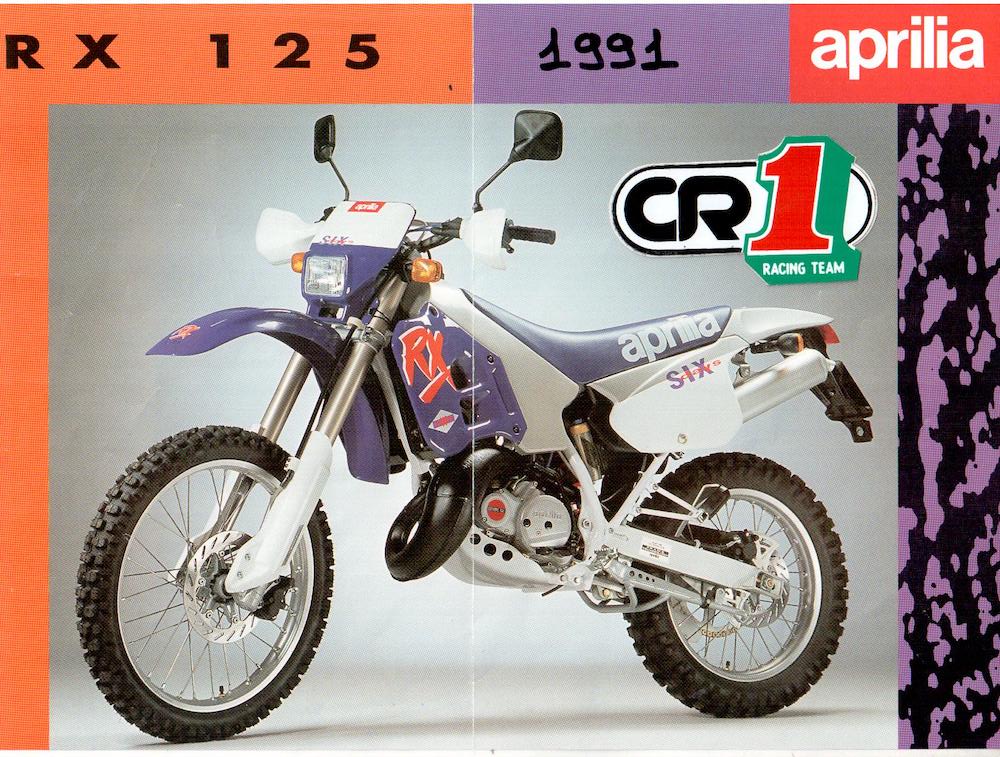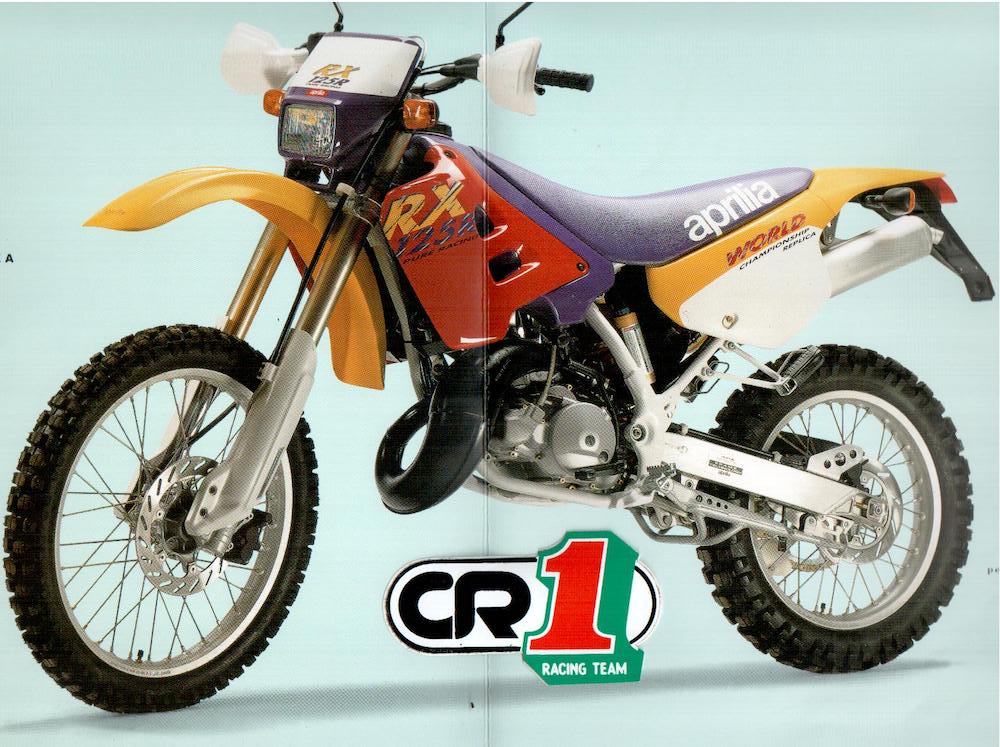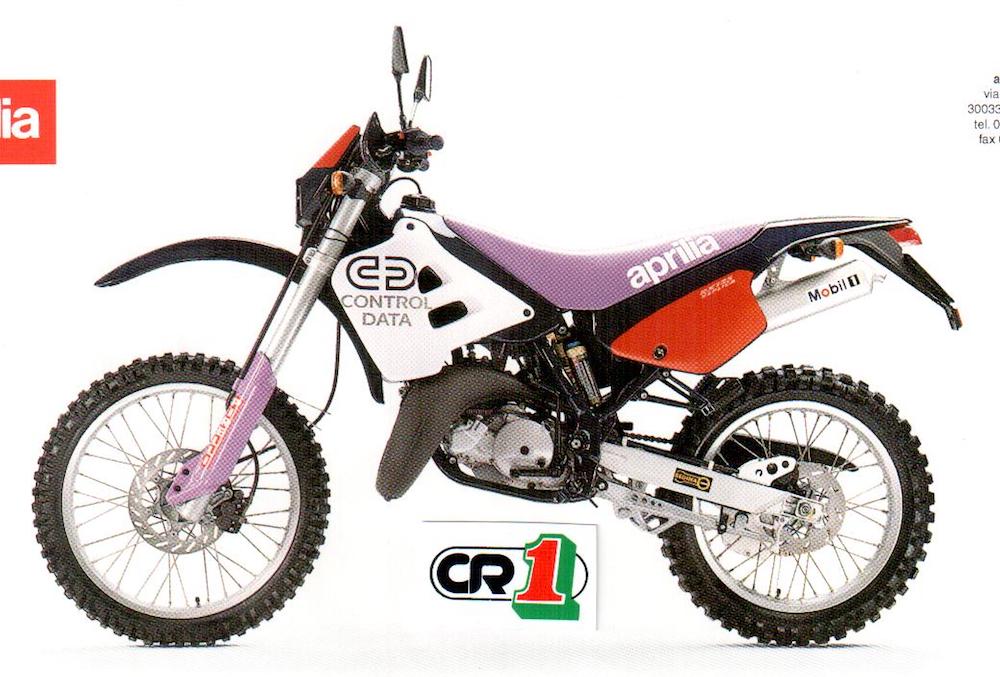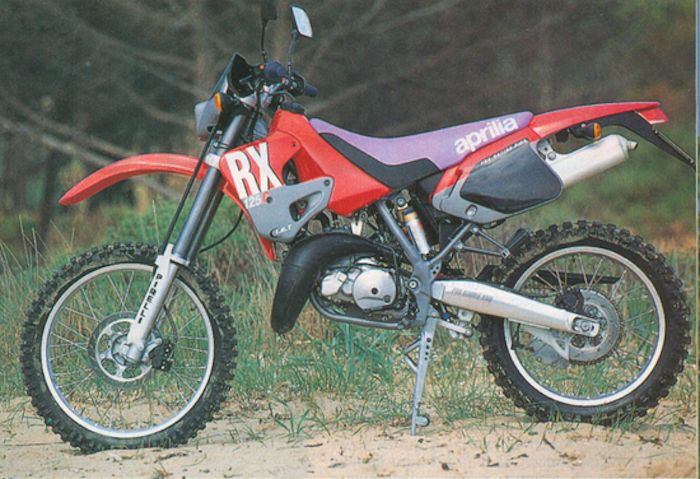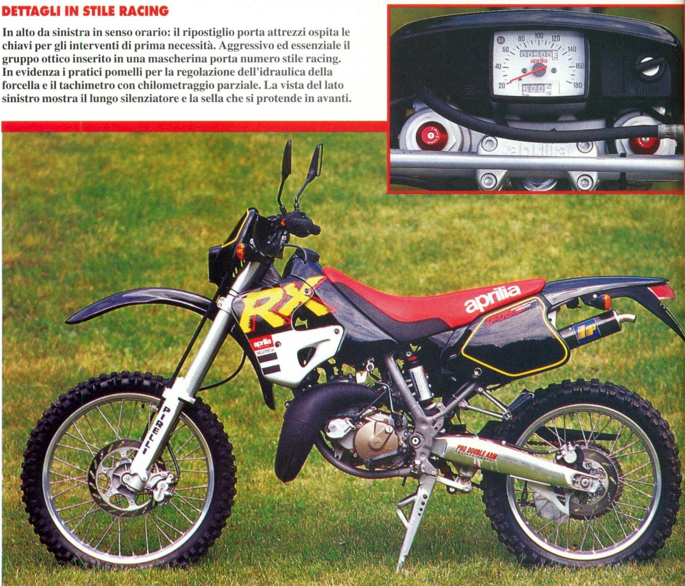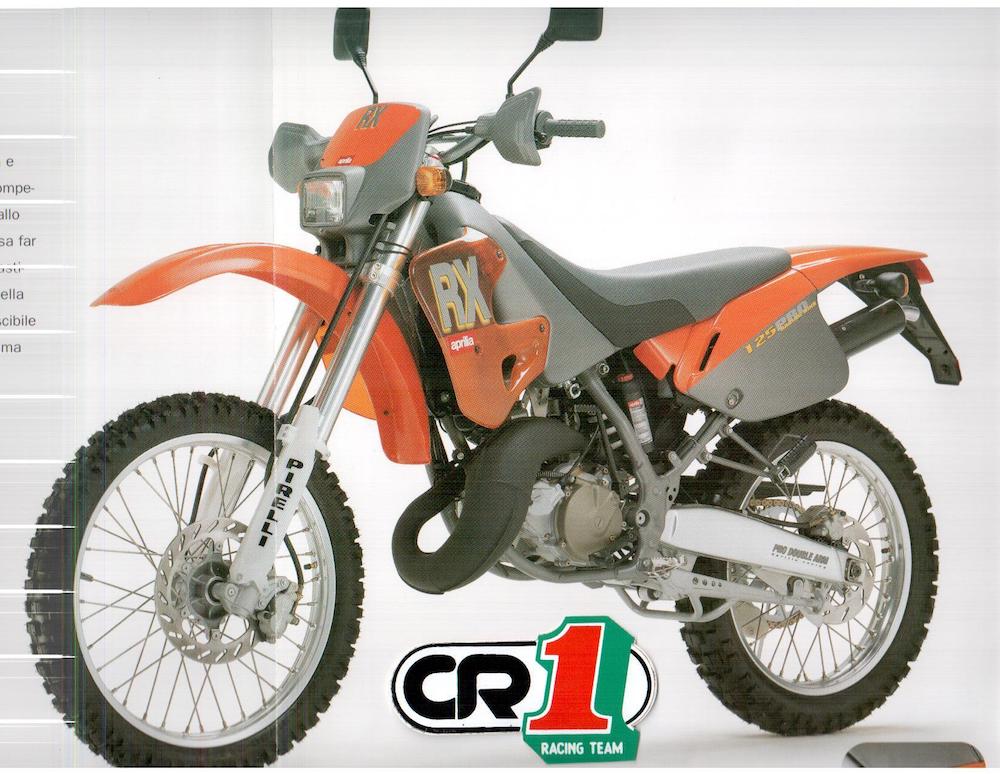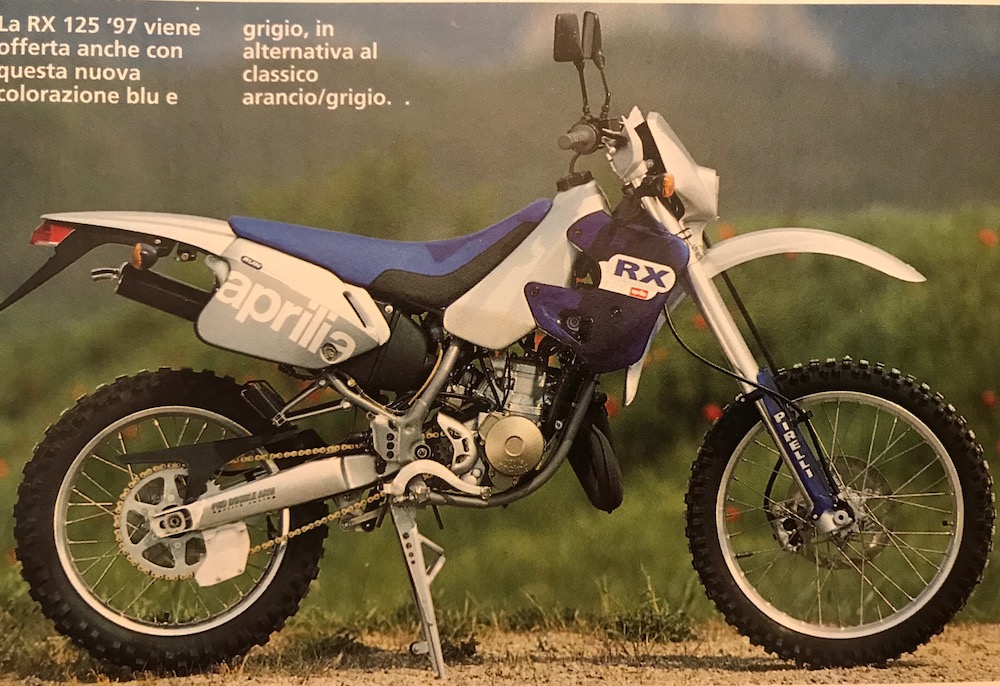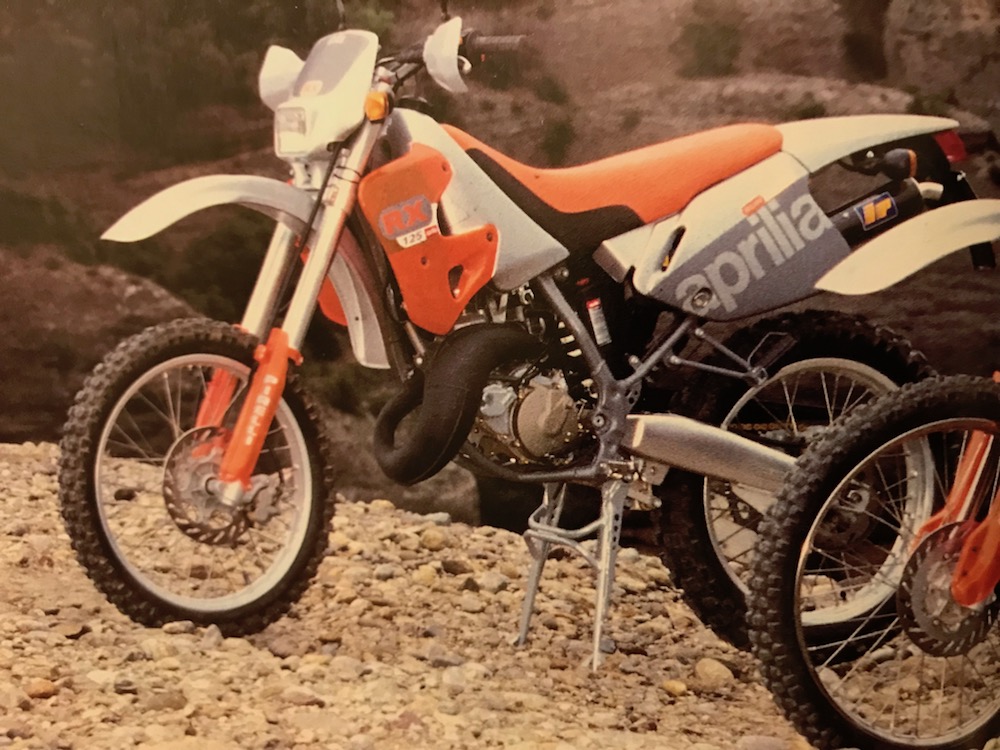Ringraziamo Massimo Russo per aver contribuito a scrivere questo articolo.
Le RX dal 1984 al 1988 fanno ancora parte della vecchia generazione di enduro della casa di Noale ed erano affiancate dalla MX125 non targata e non omologata e dalla Tuareg Rally per uso marathon. Tutte e tre le moto erano disponibili anche in versione 250. Le 125 adottavano il Rotax 127, in uso anche sulla Aprilia ETX e Tuareg (modello non Rally) che però avevano il cilindro incamiciato in ghisa e il miscelatore e privo di contralbero di bilanciamento per attenuare le vibrazioni. Le forcelle erano di tipo tradizionale con soffietti parapolvere. Le versioni “vecchie” della RX 125 avevano i freni a tamburo sostituiti da un impianto misto disco tamburo dal 1985, non erano dotate di miscelatore e le plastiche non erano verniciate.
1990: RX 125 – Tipo FD
La nuova generazione di RX 125 (Six Days) arriva nel 1990, proposta in un’unica colorazione blu e lilla. La prima serie è caratterizzata dal codice tipo FD e ha codice omologato DGM 52824 OM. Le forme erano inedite e ben curate, spigolose ma non troppo, le plastiche verniciate e di pregevole fattura. La RX ’90 sarà l’unico modello ad avere il parafango anteriore “piatto” e sarà anche caratterizzato per i mozzi ruota verniciati di rosso. Inoltre faro posteriore e targa saranno montate su un supporto asportabile in plastica nero opaco sostenuto anche esso da un telaietto in metallo nero, anche esso asportabile.
Il telaio riprende quanto visto sulla Tuareg Rally ’89, ma cambia l’inclinazione del cannotto e l’avancorsa per offrire maggiore stabilità, con la parte principale monotrave con culla sdoppiata all’altezza dello scarico e il telaietto reggisella posteriore smontabile che accoglieva pedane passeggero, vaschetta dell’olio, scatola filtro e batteria. La forcella era a steli rovesciati da 40 mm di diametro e 300 mm di corsa e il mono posteriore è un raffinato Sachs-Boge regolabile in compressione ed estensione con 30 posizioni diverse, con 290 mm di corsa, che per la prima volta viene montato su una 125 Aprilia. Il cavalletto, caratteristica ereditata dal vecchio Tuareg Rally del 84/87, è centrale e diviene un tratto distintivo delle nuove enduro di Noale.
Il motore è il classico Rotax 123 a 2 tempi con contro albero di bilanciamento a sei rapporti. Il cilindro viene identificato dal numero 223610 e risulta essere il primo cilindro ad avere i booster sulla luce di scarico introdotto su un’Aprilia, poi destinato anche alle stradali AF1 Futura Sport Production ed Extrema SP (con qualche variazione sulle luci), caratterizzato da un’erogazione molto appuntita. Il carburatore è un Dell’Orto VHSB 34 LD, mentre la valvola allo scarico è la RAVE 2 a controllo elettronico già introdotta nel 1989 sulle stradali Sintesi e Pegaso. I carter sono verniciati a polvere color marrone.
1991: RX ’91 – Tipo GP
La Six Days del 1991, codice tipo GP con codice omologativo DGM 53067 OM, sostituisce la Six Days del 1990 e viene presentata in negli eleganti colori viola dark e argento metallizzato con forme più arrotondate rispetto alla versione precedente ed un nuovo parafango anteriore. Con questa moto Stefano Passeri vinse il campionato del mondo a squadre nel 1991 nella Sei Giorni di Francia.
Le modifiche introdotte sono:
- Il telaio rimane sempre lo stesso ma cambia il telaietto reggisella posteriore, più rastremato sul lato sinistro per via della batteria da 4Ah più piccola.
- Il forcellone è inedito in lega leggera a sezione rettangolare, con terminali forgiati e saldati sui bracci principali trafilati, mentre lo smontaggio della ruota posteriore è reso più rapido e pratico dall’adozione di un perno ruota con testa opportunamente sagomata.
- Le sospensioni vedono una nuova forcella Marzocchi da 40mm con escursione di 300mm, mentre al posteriore appare nuova versione dell’ammortizzatore regolabile Boge-Sachs con articolazione APS con escursione di 300mm.
- I freni vedono un nuovo disco anteriore da 250mm (260mm il precedente) servito da pinza a doppio pistoncino. Al posteriore il disco ha un diametro di 220mm con pinza fissa. Entrambi i dischi sono caratterizzati da asole. Nuova la pinza freno anteriore.
- Nuovi anche i mozzi in alluminio che perdono la caratteristica colorazione rossa della prima versione e che hanno 32 raggi contro i precedenti 36, con un risparmio di peso di 200 grammi all’anteriore e di 600 al posteriore.
- Il propulsore rimane il Rotax 123 precedente con alcune migliore tra le quali il cilindro con numero di serie 223616 con booster di scarico, che pur mantenendo la potenza del 223610 ha una erogazione più morbida e quindi più adatta alla destinazione di utilizzo della moto. Viene rivista la carburazione (permane il carburatore VHSB 34 LD) e la cassa filtro nonché la marmitta. Rinnovato il cambio con le prime tre marce ravvicinate, mentre la trasmissione finale risulta lievemente accorciata da 14/148 a 14/49. I carter motore sono ora verniciati di grigio come su tutti i Rotax ’91.
1992: RX ’92 – Tipo GF
Il 1992 è l’anno delle la 125R World Championship Replica giallo, rosso e viola la Control Data blu scuro, verde acquamarina e bianco. La livrea della 125R WCR è un omaggio alla livrea del pilota portoghese Miguel Farrajota che con il Modello M Six Days così dipinto partecipò ai campionati del 1991 mentre la Control Data era la livrea utilizzata da Stefano Passeri nel mondiale 1992.Con il nuovo telaio la stabilità della moto aumenta notevolmente, la solidità dell’anteriore è marcata ma la posizione del pilota è più raccolta, le pedane sono più alte e arretrate rendendo la moto leggermente più scomoda e affaticante nei tratti lunghi.
- Le modifiche introdotte sono le seguenti:
- Le strutture sono completamente ridisegnate con i due convogliatori laterali assumono una forma più arrotondata e fasciano più strettamente il radiatore, mentre la curvatura della lunga sella è meno accentuata che in precedenza. Semplificata anche la linea delle fiancatine-tabelle portanumero e del parafango posteriore. Ora la moto è ancora più curata, le plastiche si raccordano meglio, le forme sono tonde e il portatarga in plastica, sparito il telaietto reggitarga, è ridisegnato e più moderno.
Il serbatoio passa dai risicati 9 litri dei modelli 90 e 91 a 12 litri di questo modello 92 ed inoltre perde le due appendici laterali che scendevano verso il basso e che rendevano l’accesso e la manutenzione a candela, carburatore e gruppo termico difficoltosa. La perdita di questi volumi e l’ulteriore aumento di ben tre litri comporterà una forma del serbatoio meno ingombrate in altezza ma nettamente più larga e, per quanto piacevole all’occhio e azzeccata, renderà la moto sicuramente un pelino meno maneggevole nella guida in piedi per via del maggior ingombro in larghezza fra le ginocchia. - Il telaio è completamente inedito e viene sottopposto ad un radicale intervento allo scopo di indirizzarlo maggiormente verso l’impiego in fuoristrada. Da notare il rinforzo presso il fulcro del forcellone, con quest’ultimo che ora è più lungo del precedente di 15mm e la posizione dell’ammortizzatore viene modificata per abbassare il baricentro.
- La forcella vede solo l’adozione di una diversa taratura interna.
- I mozzi ruota sono nuovi e permettono di montare ruote da 36 raggi invece che da 32 come nella precedente versione.
- L’impianto frenante si avvale di una nuova pinza flottante anteriore con il disco anteriore che guadagna 10 mm di diametro, tornando a 260mm. Inoltre entrambi i dischi perdono le viti a testa cilindrica ribassata avvitate su scasso e guadagnano delle più comuni viti a brugola con testa svasata ed il disco posteriore, a causa di una fragilità strutturale, rimane asolato ma perde metà delle asole rispetto al precedente.
- Il motore è sempre l’ottimo Rotax 123, di terza generazione, rivisto negli organi interni, nel carter frizione (come si evince dalla diversa forma esterna rispetto alla precedente versione) e con un attacco in più nella parte anteriore. I carter vengono semplificati internamente, il desmodromico del cambio rivisto per avere una cambiata più morbida, gli ingranaggi della quarta e quinta marcia invertiti, un nuovo miscelatore e la posizione degli ingranaggi del contagiri (non presente su RX) spostati anteriormente.

1993: RX 125 ’93 – Tipo HT
Le due moto del 1992 fanno il bis, praticamente identiche, nel 1993, la 125C di colore giallo, viola prugna e magenta e la nuova Control Data, quasi identica nelle grafiche ma blu scura, lilla e bianca. La Control Data del 1993 è la prima RX ad avere il telaio in tinta con la carrozzeria e non bianco. L’unica sostanziale differenza tecnica rispetto al modello N del 1992 è la ruota posteriore da 19 pollici invece che da 18, quindi con una vocazione più crossistica, frutto del lavoro di test e prova sui campi di gara. La moto viene però omologata con entrambe le misure vista la difficoltà tuttora corrente di trovare gomme enduro da 19 pollici omologate per l’uso in strada.
1994: RX 125’94 – Tipo
Nel modello del 1994 il telaio rimane lo stesso (diventa grigio opaco) ma cambiano le plastiche che diventano ulteriomente più crossistiche. Cambia sostanzialmente tutto il look della moto, dal colore rosso fluo e grigio opaco, al portafaro, ai portanumeri laterali, dai convogliatori del radiatore alla sella. L’unico componente che rimarrà sempre uguale per il futuro sarà il parafango anteriore. Da qui in avanti telaio, plastiche e caratteristiche tecniche rimarranno bene o male sempre le stesse. Le varianti cromatiche offerte sono due: rosso-grigio con tabelle portanumero nere o blu-grigio con tabelle portanumero rosse.
Tra le novità tecniche introdotte si segnalano:
- Forcellone completamente rivisto realizzato in lega leggera con sezione rettangolare variabile che offre maggiore resistenza alle torsioni ed alle sollecitazioni in genere.
- Il reparto sospensioni vede una nuova forcella con steli sempre da 40mm ed un escursione di 275mm, regolabile nel freno idraulico sia in compressione che in estensione con due manopole poste alle estremità degli steli.
- Il motore rimane il medesimo della versione ’93, ma il carter è fuso con una nuova lega di alluminio e silicio in grado di assicurare maggior tenuta ai carichi di rottura e snervamento, una modifica estesa a tutti i Rotax 123 ’94. L’ingranaggio della primaria viene alleggerito con fori di 24mm di diametro.
1995: RX 125 ’95 – Tipo MT
Nel 1995 la RX viene profondamente aggiornata con un telaio ridisegnato ed come per tutta la produzione Aprilia 125, riceve il nuovo propulsore Rotax 122. Le colorazione proposta è unica nero/grigio.
Nel dettaglio le modifiche adottate sono:
-
- Il telaio pur sembrando il medesimo della versione ’94, viene completamente ridisegnato, tanto che le sue compatte dimensioni permettono di abbassare la sella di 3cm e di ottenere una maggiore luce a terra, grazie anche a nuove piastre di rinforzo laterali in corrispondenza del forcellone. Ne risulta aumentata anche la rigidità della struttura.
- La forcella permane l’unità da 40mm completamente regolabile introdotta con la versione ’94, ma viene migliorata nella taratura assieme alla sospensione posteriore, per una maggior scorrevolezza.
- Il freno anteriore beneficia di una pompa di maggior dimensioni.
- Il nuovo Rotax 122 pensiona definitivamente il precedente 123. Si tratta di un motore più leggero, più preciso nelle lavorazioni e negli accoppiamenti e più facile da mantenere che rispetto al suo predecessore adotta le seguenti modifiche:
- Il gruppo termico adotta il codice 223618 (indicato sul lato dx come in precedenza), conosciuto però anche come 220H, (scritto sull’aspirazione nella zona prossima a dove si monta il pacco lamellare) che un cilindro specifico per il Rotax 122 e non intercambiabile con quelli appositi per il Rotax 123. Le differenze sono comunque minime. Il nuovo cilindro risulta solo flangiato diversamente sul carter ed i prigionieri della testata sono da 8 fori invece che da 7 fori (per l’affidabilità, non di rado nei 123 preparati i prigionieri si strappavano). Dal 1997 viene adottata una nuova testata che contiene meno acqua per aumentarne la velocità di passaggio.
- L’impianto di scarico con espansione ha ora un finale in carbonio.
- Viene mantenuto il carburatore VHSB 34 LD dotato di una nuova cassa filtro.
- Il sistema di accensione viene completamente rivoluzionato nel Rotax 122: si passa dall’ accensione semplice ed economica SEM del Rotax 123 ad una Kokusan con centralina dedicata ed anticipo variabile.
- La frizione è estraibile ed ora, pur mantenendo i medesimi dischi del Rotax 123, è possibile lavorare sul componente senza uso alcuno di pistole pneumatiche come accadeva, invece, per il Rotax 123. Il selettore marce è estraibile: un’altra chicca non presente nel Rotax 123.
1996: RX 125 ’96 – tipo MT
La RX 125 ’96 viene solamente aggiornata con una nuova ed unica colorazione arancio/grigio. Ogni componente del motore e della ciclistica rimane invariato rispetto al modello ’95.
1997: Aprilia RX 125 ’97 – Tipo
La prima RX 125 depotenziata a 15 cv. Vengono introdotte due nuove colorazioni: arancio/grgio simile alla versione ’96, ma con grafiche diverse ed un nuovo blu/grigio.
L’RX 125 viene infine pensionata nel 1999 dall’Aprilia MX 125 che condivide telaio e meccanica, ma con una estetica della carrozzeria rivista e le ruote da 17 pollici stradali da motard.

